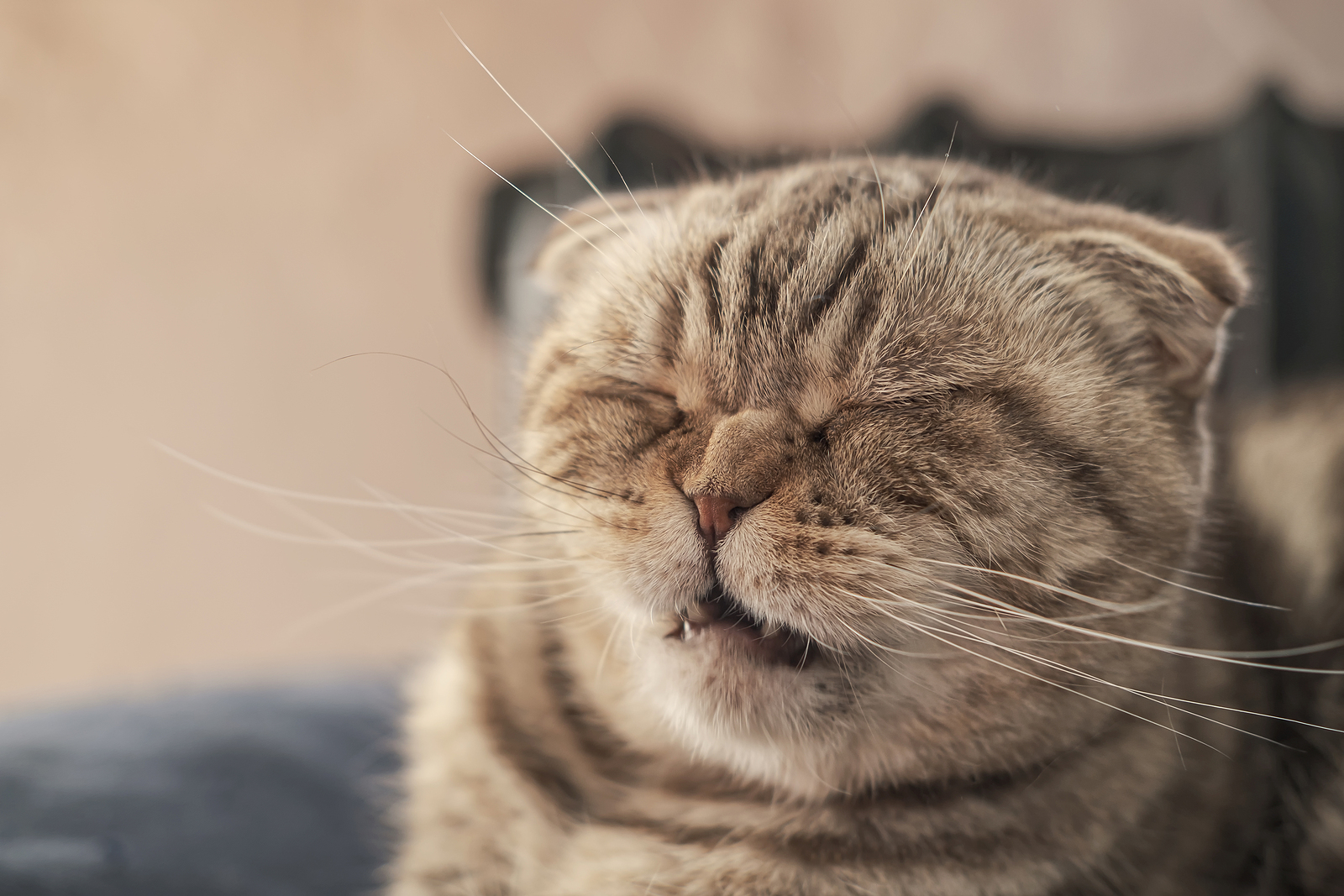
Our 4-year-old male cat Legro sneezes constantly and has snot coming out of his nostrils on and off sometimes for weeks. He also has loss of appetite and becomes sick and lethargic. Our vet has tried different antibiotics, which seem to help temporarily. Please suggest alternatives as he seems to be really suffering.
R.B., via email
Chronic feline rhinitis is a very frustrating condition not only to the cat and its owner but also to any veterinarian. I tend to provide owners with reasonable expectations and explain to them that this is a progressive condition that will slowly destroy their cat’s nasal mucosa. Although a cure is unlikely, the good news is that there are many natural methods you can try to minimize Legro’s discomfort and improve his quality of life.
Causes: Feline idiopathic (with unknown cause) rhinitis is very common and most often the result of infection by feline herpes virus (FHV). The majority (80 percent) of cats with FHV will experience recurrence throughout their lives. Even though this virus may not be isolated in PCR tests, it is still considered to be present in the nasal passages of affected cats and playing some role or triggering the development of chronic rhinitis. Any cat of any breed or age can develop this condition. However, young male cats, cats with brachycephalic features (meaning they have flat faces and noses, like Persians and Himalayans) and cats that live in dense populations fighting for the same resources seem to be more likely to acquire this disease.
Symptoms: Most affected cats exhibit some form of runny nose or nasal discharge for much of the year. Cat owners also report sneezing/reverse sneezing, congestion, stertor (a type of noisy breathing caused by nasal congestion) and sometimes coughing, too. Blocked tear ducts leading to excessive tearing of the eyes are common as well.
Loss of appetite and lethargy are other common symptoms, wherein your active cat becomes less active.
During flare-ups, the symptoms can be quite severe. Affected cats may be seen gagging, struggling to swallow and pawing at their nose or face and can also have halitosis (bad breath). Owners often report a change in their pet’s voice or the sound of their purring. Ear infections and balance issues may also occur. If the infection reaches the brain, there will be neurological symptoms like seizures or difficulty walking.
Diagnosis: Your vet will rule out other possible causes of nasal discharge such as a foreign bodies like grass seeds stuck in the nose or mouth, an oronasal fistula (abnormal opening between the mouth and nasal cavity), tumors, nasal polyps and sometimes dental infections. X-rays and deep nasal swabs to test for bacteria may be needed apart from a full clinical exam of the ears, eyes, nose, throat and teeth. Blood tests and tissue biopsies may also be required to rule out fungal causes like aspergillosis and cancer. Feline idiopathic rhinitis is then the default diagnosis after eliminating all other causes listed above.
Treatment: Conventional treatment focuses on managing the chronic inflammation with steroids and treating the secondary bacterial infection with antibiotics. Over time, drug resistance develops, and nothing seems to work. Antivirals and antihistamines also become ineffective. Conventional vets then advice nasal flushes, saline nebulization, immunotherapy and even low-dose radiotherapy. Beyond that, many alternative therapies may help.
DIET
Cats need to smell their food to enjoy it, and when their nose is blocked or runny, their sense of smell is affected. As a result, they lose interest in food and stop eating. Feeding strong-smelling food like tuna or other fish can help. Appetite stimulants like alfalfa (Medicago sativa) can be tried, too. Bone broth as a source of nutrition is also a good idea. Dairy and wheat should be avoided as they contribute to thick mucus formation and make matters worse.
Many cats with chronic rhinitis can get dehydrated due to the constant leaky nose. Water fountains, access to fresh water and broth in drinking water can help keep them hydrated. Feeding raw or fresh whole food is also a good idea.
ENVIRONMENT
Cats are extremely sensitive to environmental airway irritants that they inhale, so reducing airway contaminants can help manage this condition. As much as possible, avoid cigarette smoke, wood fire smoke, dusty cat litter, plug-in air fresheners, candles, citrus-based cleaners and deodorizers. New carpets, household renovations, strong perfumes and other pet dander, especially from birds, can all trigger allergic rhinitis in cats.
Ensuring safe sleep and play areas and enriching his environment with toys, hideouts, climbing frames and the like can also help your cat relax and cope better with his ailment. Cats are not fans of new people and pets, so care should be taken to ensure they are not subjected to excess stress from new situations.
WESTERN HERBS
A combination of herbs—antimicrobials, so-called “demulcents” to soothe the mucous membrane, and immune stimulants—can be used for chronic rhinitis. Herbs to support the immune system are needed as they help the cat mount an adequate immune response. Super Immune from Animal Essentials and Peak Immune from Glacier Peak Holistics are good supplements that include a range of herbs. Echinacea and Goldenseal tincture from Nature’s Answer can be used short term during an acute attack.
Respicalm and Breathe EZ, also from Animal Essentials, can help with cough and nasal congestion. Ashwagandha, licorice, marshmallow, Siberian ginseng and astragalus are herbs that can be given under the guidance of an herbalist.
Mushrooms can be added in for immune support, particularly reishi, shiitake, maitake and cordyceps. Dr Mercola’s Mushroom Complex, RxCoriolus Forte by Rx Vitamins, CAS Options by VetClassics and Immunity Organic Mushroom Mix by Four Leaf Rover are good products available online that can be used long term.
SUPPLEMENTS
L-Lysine is an essential amino acid for cats that supports respiratory tissues and promotes the well being of the immune system, eyes and general respiratory health. Cats like VetriLysine Plus and L-Lysine Pro from VetriScience and Viralys Gel L-Lysine from Vetoquinol.
Recommended dosage: 250–500 mg by mouth twice daily
Vitamin C is a potent antioxidant and immune system booster.
Recommended dosage: 200 mg by mouth twice daily
TCVM
Traditional Chinese veterinary medicine (TCVM) has some great formulas to help cats with chronic rhinitis. My favorite is Bi Yan Pian from Kan Herbs. It clears wind and dispels toxic heat. The dosage is on the product bottle. If possible, consult a TCVM-trained practitioner for better results.
ACUPUNCTURE/ACUPRESSURE
Stimulating the following points once or twice daily for 30 seconds is beneficial. See my book, You Can Heal Your Pet, to learn how to administer acupressure to your pet.
GV 20 “Governing Vessel 20” is known as the point of 100 convergences, or the summit of the bodily mountain. It is located at the top or crown of the head, in a depression that is in line with the ears.
LU 7 “Lung 7” is located immediately above the wrist bone in a tiny depression on the inside surface of the front paw. By just massaging this point, it is possible to help your pet breathe more easily
BL 13 “Urinary Bladder (BL) 13” is located on either side of the spine, starting from the shoulder blades at the third rib space. Massaging in a back-and-forth motion for a couple of minutes is beneficial for restoring proper balance.
LI 4 “Large Intestine 4” is located on the front paw in the depression of the dewclaw webbing, or where the thumb and forefinger meet. Massaging it increases protective qi circulation and can contribute to a long, healthy life. It is also useful for reducing aggression and for relieving allergies, aching neck, shoulder pain, a blocked nose or even sinus problems.
ST 36 “Stomach 36” is located behind the tibial crest, on the outer surface of the back leg, just below the knee in a depression where the lower leg (tibia) joins the knee.
Nebulization The Omron NEC801 nebulizer can be purchased online. It is not expensive, can be held as close to the nose as possible as it is quiet, and can be used with herbal teas or saline. It is well tolerated by cats as they get used to it and realize they feel better afterward.
Steam inhalation Encourage your cat to venture into the bathroom while you take a hot shower to help break up mucus.
Energy healing Pet Reiki and hands-on-healing are good for respiratory issues.
Essential oils Open Air from Animal EO can be used in a water-based diffuser.
Assisi Loop or pulsed electromagnetic field (PEMF) therapy is a device placed on the cat and used three times daily for 15 min, which has been reported to be beneficial for inflammation.
Although chronic rhinitis cannot be cured completely, there is much that natural medicine can do to help. Integrative treatment combining antibacterials and adjunctive therapies like the ones listed above to keep your cat comfortable and snot free is the aim.

What do you think? Start a conversation over on the... WDDTY Community